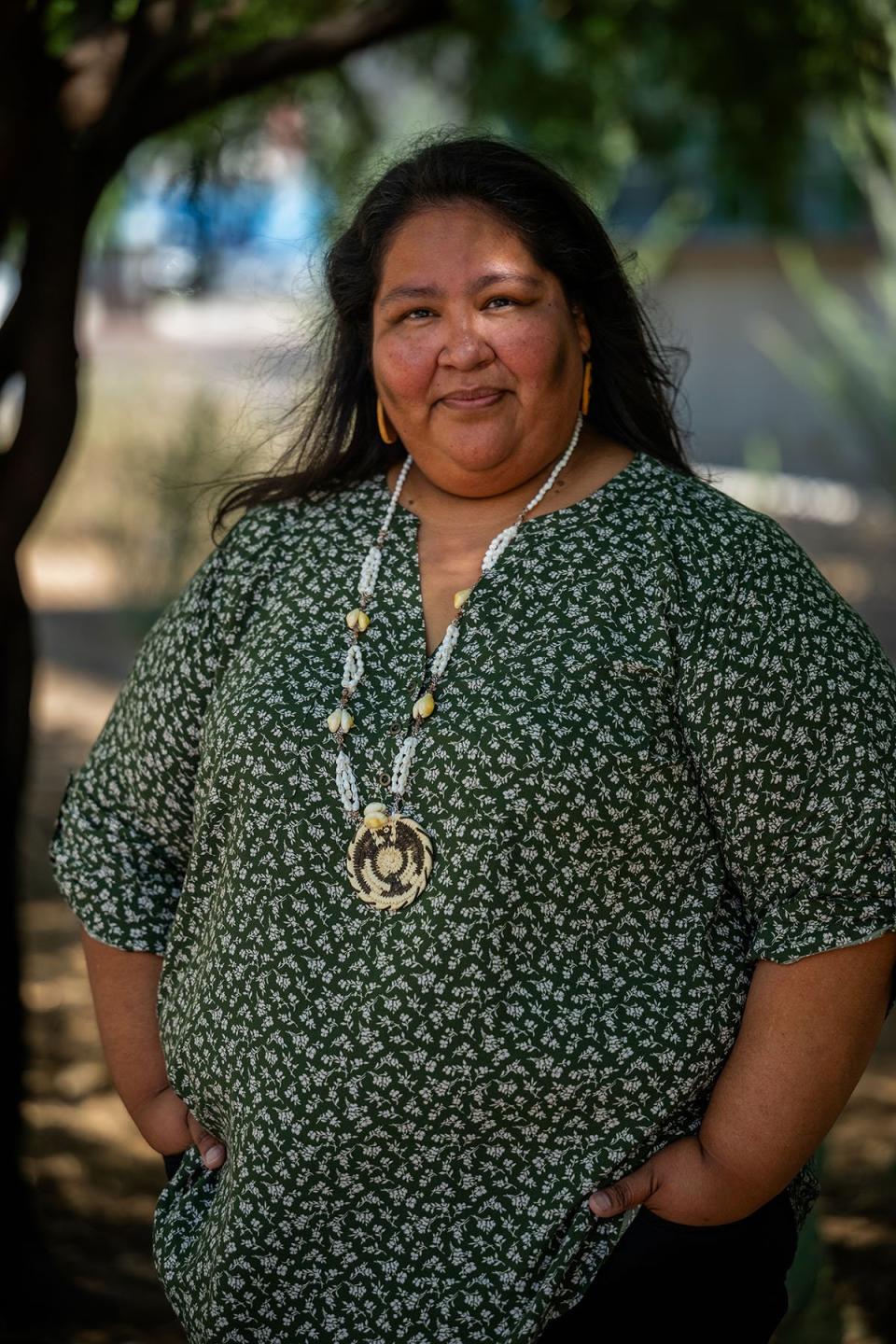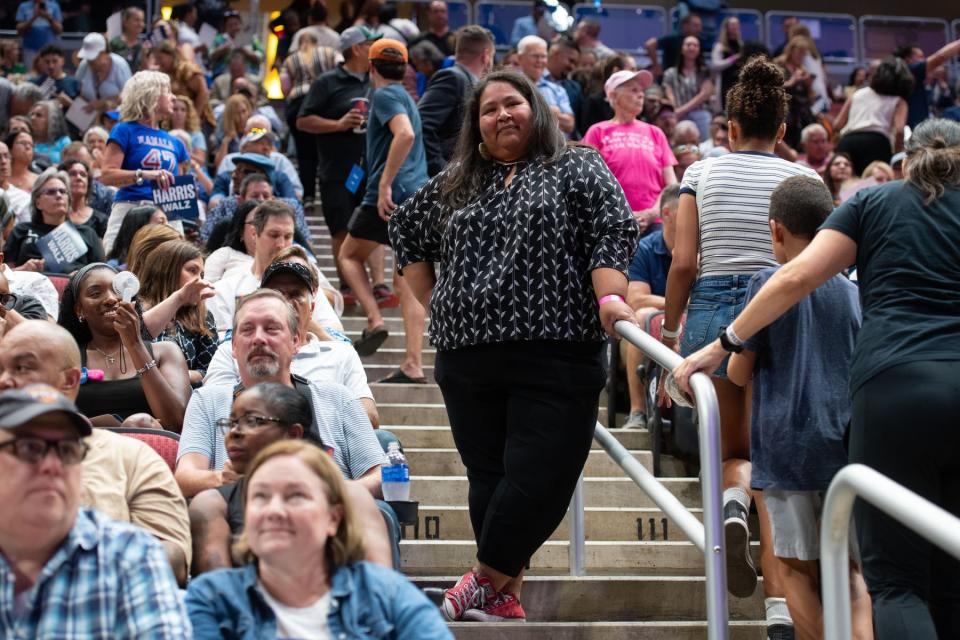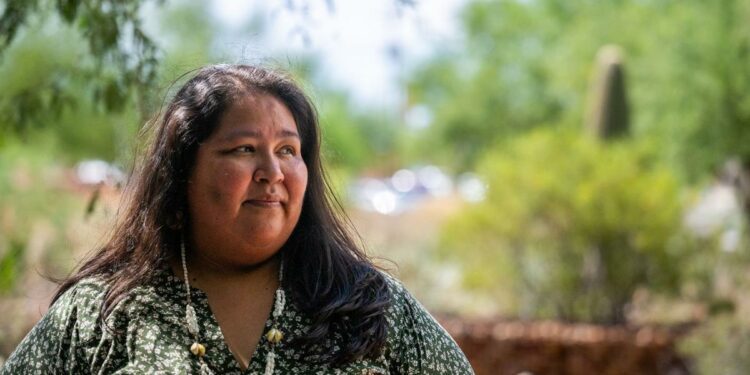Gabriella Cﺣ۰zares-Kelly works in her office in Tucson, Arizona. (Ash Ponders for The 19th)

A wall displays framed portraits of Pima County Recorders, including Cﺣ۰zares-Kelly, at her offices. (Ash Ponders for The 19th)
She launched her campaign in 2020, right at the start of the COVID-19 pandemic. That meant having to canvass neighborhoods with social distancing measures in place, doing no-contact lit drops and outreach through Zoom forums and virtual fundraisers.
Worse, a candidate who wanted to win her community would need to do a lot of driving ﻗ and her car was having engine problems. She needed money to get back on the road. When she was registering voters, she sold banana bread to pay for gas. But fixing the car would take a much bigger sum, and she felt bad asking for money from people who might not have any to spare. A friend assuaged her guilt: ﻗI think youﻗre saying, ﻗHey, community, Iﻗve invested in you,ﻗﻗ she recalls him telling her. ﻗNow youﻗre asking, ﻗCan you invest in me?ﻗﻗ
She set up a GoFundMe for $3,500 and quickly met the goal. ﻗIt was just shocking to me that people would give me money,ﻗ she said. But it didnﻗt surprise her husband, a former teacher who is now a labor organizer with the AFL-CIO. Because she never wanted to get into politics, she had won community support just by being herself, he said. ﻗGabby walked into the race already having so many meaningful community relationships,ﻗ he said.
Those ties had deepened in 2017, when she, her longtime friend April Ignacio and a few others co-founded an advocacy organization called Indivisible Tohono. They have organized everything from sock drives to candidate forums to Pride events on the Nation.
That network of friends was ready to spread the word about her campaign. It helped that she made a Tik Tok video that went viral, showing her speeding by the National Mall in Washington, D.C. on an electric scooter while wearing a traditional red dress and yelling, ﻗExcuse me, Iﻗm Indigenous, coming through!ﻗ That moment became part of her campaign slogan and bumper sticker design.
So when Election Day came, her supporters were hopeful that she might have a shot. ﻗWe had a good group of people who are really all rooted in the community,ﻗ her husband said. ﻗI think we quietly suspected that it was going to be a landslide victory.ﻗ
And they were right. She beat her opponent by more than 80,000 votes.
Ignacio said it was a barrier-breaking moment for Cﺣ۰zares-Kelly. ﻗAs a rez girl growing up, we didnﻗt have the idea that we could do this. We didnﻗt have people in our community who were doing things like this,ﻗ she recalled. ﻗFor me to watch my best friend make history, itﻗs still very emotional. And I think that sheﻗs the star who sheﻗs always been.ﻗ
Cﺣ۰zares-Kelly followed the canvassing in Three Points with a Juneteenth event in Tucson, where she gave the land acknowledgment at the opening ceremony, recognizing tribes like her own that have stewarded the land. Then she stayed to mingle with the crowd. As she strolled by the booths ﻗ some selling lemonade, others representing the gun reform group Moms Demand Action and the African American Democratic Caucus ﻗ people stopped her to shake her hand and fangirl about meeting her.
Sheﻗs something of a local celebrity, which she didnﻗt expect as an elected official doing an administrative job. When she ran, ﻗit wasnﻗt a sexy position,ﻗ she said. ﻗMost people didnﻗt care about the recorderﻗs office.ﻗ
Two things contributed to her popularity. One is that Cﺣ۰zares-Kelly, despite her initial shyness, is charismatic and funny and beloved by Pima County voters, who cast more votes for her than any other Democratic countywide candidate in the July primary. The other, a more somber reality, is that the 2020 election raised the profile of county recorders after the Trump administration spread unfounded conspiracy theories that votes in Arizona werenﻗt being counted.
That fundamentally changed how she had to run her office. She immediately created a communications team to counter disinformation and teach people how voting works. In May, they invited a small group of community members and journalists into a highly restricted part of the office to see how ballots are counted. She also recently hosted a series with the Pima County Interfaith Council, visiting five churches to talk about a ﻗday in the lifeﻗ of the ballot. She draws inspiration from educational programs like ﻗMr. Rogersﻗ and the ﻗHow Itﻗs Madeﻗ videos about crayons or peanut butter. ﻗI think people just want to know those types of things,ﻗ she said.
She also uses social media to spread information about voting, tailoring the messages to the medium. Twitter is for journalists and other ﻗnerds,ﻗ as she put it, so she tends to be wonkier there. Facebook and Instagram are for people like her sister, who donﻗt really care about the granularity of politics, but might be enticed if she can explain what her office does.

Pima County voters cast more votes for Cﺣ۰zares-Kelly than any other Democratic countywide candidate in the July primary. (Ash Ponders for The 19th)
ﻗI think people have for a really long time been very dismissive of social media,ﻗ she said. ﻗBut we can very much see a parallel between what happens on Twitter and Instagram and what happens in person.ﻗ For example, she said, when Kari Lake, a far-right Republican who ran for governor in 2022 and is now running for the U.S. Senate, sent out a tweet suggesting ballot counting was being slow-rolled to prevent her from winning, ﻗit results in physical phone calls to my office.ﻗ
Voter outreach will matter a lot this year, in what former recorder F. Ann Rodriguez describes as a ﻗbig electionﻗ for both the county and the nation. She points out that Pima is Arizonaﻗs second most-populated county, after Maricopa, which happens to be one of the fastest-growing counties in the United States. And several hot-button issues will bring out voters: This year both abortion rights and the wages of restaurant workers are on the Arizona ballot.
For now, a lot of Cﺣ۰zares-Kellyﻗs work happens at events like this one, where she can answer questions in person. At the booth for NextGen America, which focuses on getting out the youth vote, she chatted about how the work was going and offered a pro tip learned from years of dealing with registration hassles: Instead of asking if someone is registered to vote, ask if they are registered at their current address. (Sometimes people move without updating it.)
Two booths down, at the Saavi Services for the Blind tent, she talked to Mohammed Falah about a tool called a ballot marking device ﻗ a machine that helps people with disabilities vote. It can read a ballot to a person through headphones, offers functions for large print or color contrast and has a controller that people with hand mobility issues can use to select their voting option. She said her office would be happy to demonstrate it for his organization.
The county had the machines before she came into office, but, she said, much of the staff didnﻗt know how to use them. ﻗThey were like a nice decorative thing on the side of the room and if somebody asked to use it, [staff] would have to take out the instruction booklet and troubleshoot,ﻗ she said. ﻗThen that personﻗs having to wait. And often it would lead to people feeling discouraged and embarrassed. And, you know, they may choose not to participate.ﻗ
Listening to what the community needs, Cﺣ۰zares-Kelly said, ﻗmakes it better for everybody.ﻗ Sometimes itﻗs as simple as having a table with chairs at early voting locations. Older people started requesting that accommodation, she said, ﻗbut then we would see people who come in with a boot on their foot.ﻗ Once, she watched a mom sit down to breastfeed her child while voting.
Her office has taken other accessibility measures, like making sure that PDF documents are compatible with a screen reader, a tool that can read text aloud or translate it into Braille. All of her social media communications include an image description for the same reason.
As of 2016, there were about 175,600 visually impaired people in Arizona, and the population is aging, Falah said. This means more people will soon need these accommodations. ﻗWe are a retirement state,ﻗ he said. ﻗIf we do not tackle it now, then when?ﻗ
A few weeks later, Cﺣ۰zares-Kelly was standing in front of a class of soon-to-be graduates from a training program that helps Indigenous people overcome the unique challenges theyﻗll face whileﺡ running for office. Native politicians are often some of the first from their communities to either run or hold their positions and that usually comes with a fair amount of pushback or skepticism.
Cﺣ۰zares-Kelly opened her talk by greeting the students in the Tohono Oﻗodham language. Switching back to English, she said, ﻗYou are on Oﻗodham land.ﻗ Then she added, with a smirk, ﻗSo ﻗ۵ youﻗre welcome.ﻗ The group burst into laughter. It felt like a cheeky inside joke for a group of people whoﻗve likely been asked to do land acknowledgements for non-Native audiences. But the lighthearted moment quickly turned serious as Cﺣ۰zares-Kelly launched into the story of how she became involved in voting rights work thanks to her earliest influence, her grandmother.
Cﺣ۰zares-Kelly grew up in two different communities in the Tohono Oﻗodham Nation. One is called Kupk, a remote place where she spent her summers. The rest of the year, she lived in the village of Pisinﻗ Moﻗo, which had some services, like a bus stop. She lived next door to her grandmother, Catherine Josemaria. Cﺣ۰zares-Kelly refers to her affectionately as her Huﻗuli-bat, which is Oﻗodham for ﻗmy dearly departed motherﻗs mother.ﻗ
They would communicate across their two languages, her grandmother in her broken English and Cﺣ۰zares-Kelly in her broken Oﻗodham. They were always together, she said. Her grandmother showed her how to harvest traditional foods and she recalls watching her grind corn and clean tepary beans in the kitchen.
But she also remembers another tradition: her grandmotherﻗs voting ritual. It was a right Josemaria did not have until she was 30 years old. She was born in 1918 and granted citizenship six years later, but it wasnﻗt until 1948 that Native Americans won the right to vote. Even then, for decades, voting barriers like literacy tests specifically disenfranchised non-White and Indigenous people.
But that didnﻗt stop Josemaria from being politically active. ﻗShe was a brilliant woman and she was a community leader,ﻗ Cﺣ۰zares-Kelly told the group. ﻗWe had visitors every single day of my youth, people wanting to hear her stories and her gossip ﻗ she was the gossip queen ﻗ and get her advice and have political discussions with her.ﻗ
On election days, Cﺣ۰zares-Kelly would comb and braid her grandmotherﻗs long gray hair and pin it up in a bun. Her grandmother would don a dress and a little purse, and Cﺣ۰zares-Kelly would help her into the passenger seat of her car. Cﺣ۰zares-Kelly was too young to legally drive, but it was pretty common to start driving young on the reservation ﻗ and extremely important to get her grandmother to the polls. It only occurred to her later that what her grandmother was doing was a big deal, an act of defiance. ﻗShe would not have had the full freedom of having a language translator until the mid 1970s, which isnﻗt that long ago,ﻗ she said.
Once they returned home, her grandmother would go to her bedroom and tack her ﻗI votedﻗ sticker on the vinyl faux wood wall next to other stickers she had collected over the years. The oldest ones, Cﺣ۰zares-Kelly remembers, were yellow and worn.
The importance of those stickers stayed with her. They serve as reminders to vote and are a source of pride. Itﻗs part of the reason why in 2022, Cﺣ۰zares-Kellyﻗs office released new stickers for early voters with the words ﻗI votedﻗ written in English, Spanish and Oﻗodham, one on top of the other.
Her office has also expanded the role of the Tohono Oﻗodham outreach coordinator to spend more time in the field talking to tribal residents and made it a priority to reinstate an early voting site for the Pascua Yaqui Tribe. The tribe had sued the previous county recorder after she closed the site in 2018 just a few weeks before an election. (A judge sided with the decision to close the site, saying there wasnﻗt evidence that closing it made it harder to vote.)
Sestiaga recently told Cﺣ۰zares-Kelly how crucial that voting center has been for him. Even though heﻗs not a member of that tribe, voting at a site where people look like him makes him feel safer. He used to vote at a church in a predominantly White neighborhood and ﻗgoing in as the young, Brown-skinned, darkest person in the room, I got looked at. I felt like people were watching me, like I was getting judged.ﻗ
Sestiaga is able to vote at that site due to a change the county government made in 2022: Instead of having to go to a specific precinct, a resident can vote at any center in the county. Eleven other Arizona counties use this model and its popularity is spreading. According to the Voting Rights Lab, an advocacy organization, voter centers are more convenient, widely popular and could increase turnout.
The centers also make voting easier for people on the reservation. As with any rural area, if someone shows up at the wrong precinct, it can be a long drive to the right one. And not everyone can afford that kind of error, said Cﺣ۰zares-Kelly. Many people donﻗt have cars or canﻗt afford to spend extra money on gas. Public transportation systems arenﻗt reliable, if they exist at all.
As she wound down her speech at the leadership conference, Cﺣ۰zares-Kelly reminded the students that running for office is about advocating for their communities ﻗ not just when it comes to voting rights, but other policy decisions that are shaped by elected officials, like in health care or infrastructure.
ﻗItﻗs our duty to protect our community,ﻗ she told them. ﻗAnd if that means that weﻗre not doing it in the traditional way, but weﻗre having to learn the language of government and policy and funding to protect our people, then itﻗs our duty to at least try.ﻗ
A few weeks after she announced she would run for president, Kamala Harris held a rally in Glendale, Arizona, a sprawling suburb just outside Phoenix. As she watched one of the opening speakers, the governor of the Gila Indian River Community, come up to the stage, Cﺣ۰zares-Kelly exclaimed, ﻗThereﻗs hella Natives up in this piece!ﻗ
Harris and vice presidential nominee Tim Walz talked about some of the most pressing issues in Arizona: immigration and abortion restrictions. Harris also promised to pass the John Lewis Voting Rights Advancement Act, which would strengthen protections against discriminatory voting practices.
Cﺣ۰zares-Kelly was happy to hear it. But on the drive back home, she said that some of the things she heard at the rally didnﻗt resonate with her, like when Arizona Sen. Mark Kelly talked about the ﻗarmyﻗ Democrats need to win the next election. Her tribe, whose ancestral lands straddle both sides of the border, is heavily surveilled by the border patrol, which has a history of harassing and even deporting tribal members. The military rhetoric, she said, ﻗdoesnﻗt make me feel safe.ﻗ
Though she is a registered Democrat and a delegate at the Democratic National Convention, she stands to the left of the Harris-Walz ticket and has felt conflicted by its more moderate stances. Also, as an Indigenous person, her identity is inherently political. One of her idols, Minnesota Lieutenant Governor Peggy Flanagan, a citizen of White Earth Band of Ojibwe, once put it this way: These political systems were not designed to include people like her, but to eradicate and assimilate Indigenous people.

Gabriella Cﺣ۰zares-Kelly poses for a portrait before a Harris Walz campaign rally at Desert Diamond Arena in Glendale, Arizona. (Caitlin OﻗHara for The 19th)
ﻗSo weﻗre still fighting the structure of white supremacy and anti-Indigenous sentiment and all of these other issues,ﻗ Cﺣ۰zares-Kelly said, ﻗand weﻗre having to change the culture about what our role is in that.ﻗ
Eventually, the conversation turned to her own political future. Already, people have been speculating about whether sheﻗd consider a higher office, but she promised herself sheﻗd stay in the role for at least two terms. ﻗI donﻗt know how Iﻗll feel in another four years, but four years has flown by for me,ﻗ she said.
It was past 10 p.m. and she was still making her way home. But the long day hadnﻗt sapped the energy in her voice or her enthusiasm for the job.
ﻗThere is so much work to do,ﻗ she said.
The post How a Native elections official is breaking down voting barriers in Arizona appeared first on The 19th.
News that represents you, in your inbox every weekday. Subscribe to our free, daily newsletter.
Source link : http://www.bing.com/news/apiclick.aspx?ref=FexRss&aid=&tid=66d70093cc5142558367ceda47ba0b81&url=https%3A%2F%2Fwww.yahoo.com%2Fnews%2Fnative-elections-official-breaking-down-100000737.html&c=5970560459417249114&mkt=en-us
Author :
Publish date : 2024-09-02 23:00:00
Copyright for syndicated content belongs to the linked Source.












